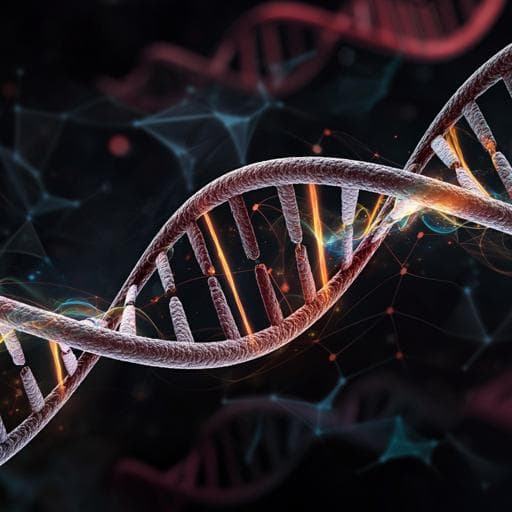
Medicine and Health
Benefits for children with suspected cancer from routine whole-genome sequencing
A. Hodder, S. M. Leiter, et al.
This groundbreaking research unveils how clinical whole-genome sequencing (WGS) can enhance the treatment and management of children with suspected cancer. Conducted by a team of experts including Angus Hodder and Sarah M. Leiter, the study demonstrates that WGS can provide vital insights and opportunities for molecularly informed care.
~3 min • Beginner • English
Introduction
The study investigates whether routine whole-genome sequencing (WGS) offered to all children with suspected cancer provides clinical benefits beyond standard-of-care (SOC) molecular testing and can change patient management. WGS is the most comprehensive single assay for detecting all major classes of genomic variants, and prior work has shown particular promise in pediatric oncology where treatment is often genomically guided. However, evidence for routine, real-time clinical utility across unselected pediatric populations is limited, with most prior studies focusing on high-risk or selected cohorts. In England’s National Health Service (NHS), a centralized WGS program exists, but uptake varies. Two centers (Great Ormond Street Hospital for hematologic malignancies and Cambridge University Hospitals for solid tumors) systematically implemented WGS for consecutive patients, enabling an observational evaluation of clinical utility, turnaround times, and concordance with SOC assays.
Literature Review
Previous studies demonstrated feasibility and potential clinical utility of WGS and integrative genomic profiling in pediatric oncology, particularly in high-risk or relapsed disease settings. National and international initiatives (e.g., NHS Genomic Medicine Service, Australian Zero Childhood Cancer Program, Swedish GMS Childhood Cancer project) have incorporated WGS into clinical pathways. Prior research indicates WGS can yield additional actionable or diagnostically relevant findings even when broad SOC panels are used, and it can uncover underexplored aspects of pediatric tumor genomics. Despite these advances, there has been a paucity of evidence addressing whether routine deployment to all suspected pediatric cancers provides real-time, practice-changing benefits compared to SOC testing. This study seeks to fill that gap by assessing WGS utility across consecutive cohorts in routine clinical service.
Methodology
Design: Observational study across two English tertiary pediatric oncology units: Cambridge University Hospitals (CUH; solid tumors) and Great Ormond Street Hospital (GOSH; hematologic malignancies). Two phases were analyzed: an implementation phase (clinician-selected patients) followed by a routine phase (aiming to offer WGS to consecutive eligible patients). Ethics approval reference: 22/WA/0281.
Participants and sampling: 281 children (282 tumors) were included (CUH n=130; GOSH n=152). Tumor DNA was obtained from peripheral blood/bone marrow (liquid tumors) or fresh-frozen tissue (solid tumors); germline DNA from disease-free blood, unaffected marrow, or skin biopsy. Local pathologists ensured adequate tumor cellularity.
Sequencing and analysis: WGS performed within the NHS via Genomics England (GEL) and regional Genomic Laboratory Hubs (GLHs). Illumina short-read sequencing at mean coverage ~108× (tumor) and ~43× (germline). Centralized calling of substitutions, indels, copy-number alterations, and structural variants via the GEL Cancer Genome Analysis Pipeline. The clinical pipeline also provided mutational signature analysis (COSMIC v2.2); de novo research re-extraction used SigProfiler (COSMIC v3.3) for data resource purposes.
Clinical workflow: Automated GEL WGS reports were retrieved by GLH scientists, interpreted in clinical context, and discussed at Genomics Tumor Advisory Boards (GTABs) comprising reporting scientists, clinical geneticists, pathologists, and treating clinicians. Turnaround time (TAT) was measured from test request to GEL report availability and to GTAB sign-off.
Impact assessment: Site investigators prospectively collected SOC and WGS results; cases were retrospectively reviewed by at least four investigators using consensus impact definitions. SOC encompassed locally accepted practice stratified by diagnosis, including assays such as copy-number arrays, FISH, mutation-specific IHC, targeted DNA and RNA panels, and germline tests as indicated. WGS impact categories included: aided diagnosis, therapeutic opportunity, and changed management, with strict criteria attributing management change only to findings uniquely delivered by WGS and not obtained (or expected) via SOC.
Statistics and reproducibility: No predetermined sample size; randomization and blinding not applicable. Data handling in Microsoft Excel; figures in Adobe Illustrator; signature analyses in R Studio and SigProfiler.
Key Findings
Cohort and operations: 282 tumors from 281 children (19 relapses, 7%). Routine-phase recruitment captured 93% (GOSH) and 90% (CUH) of eligible patients with near-universal consent (289/291). Median TAT decreased over time: 18 days (range 9–64) for solid tumors and 19 days (11–71) for hematologic malignancies.
Concordance with SOC: Across the cohort, 738 SOC molecular tests were performed. WGS reproduced all SOC findings (including negative results), indicating complete concordance.
Added findings beyond SOC: WGS revealed 108 additional disease-relevant features in 83/282 cases (29%). Of these, 80 instances provided clinical benefit (across 69 cases, 24%). Benefit domains: aided diagnosis (n=40, 14%), therapeutic opportunities (n=20, 7%), and changed management (n=20, ~7%).
Changed management (~7%; 20/282): Findings uniquely attributable to WGS led to immediate care changes, including: risk stratification adjustments (e.g., KMT2A-USP2 fusion in mixed-phenotype acute leukemia prompting transplant; IGH-DUX4 in B-ALL avoiding escalation despite slow response), diagnostic resolution altering therapy (e.g., WGS-supported rhabdomyosarcoma vs pleuropulmonary blastoma, enabling appropriate maintenance therapy; PDGFRB mutation diagnosing myofibroma treated as benign), and germline predisposition discoveries directly modifying treatment (e.g., PALB2 variant in neuroblastoma altering radiotherapy fields; TRIM28 mosaicism in Wilms tumor guiding predisposition-specific chemotherapy).
Aided diagnosis and acceleration: Particularly impactful in non-neoplastic bone marrow failure (n=17) where WGS consolidated multiple gene panels into a single test with median 17-day TAT, expediting definitive therapy.
Therapeutic opportunities: 20 cases had mutation-guided options identified (including RAS pathway inhibitors and checkpoint inhibitors), though not necessarily administered upfront.
Novel genomic insights: WGS identified previously undescribed or disease-defining features in 6 cases, including FOSL1 rearrangements in desmoplastic fibroblastoma; ATXN1-NUTM2D fusion in an infant high-grade brain tumor; novel fusion partners (PAX5-NOC1 in B-ALL; NOTCH1-MTA1 in T-LL), and UV mutational signatures in pediatric ALCL.
Service model insight: WGS could, in principle, replace the battery of SOC assays, potentially consolidating testing and conserving tissue, given complete concordance and broader discovery capability.
Discussion
Routine clinical WGS across unselected pediatric oncology cohorts yielded tangible, practice-changing benefits, extending prior findings from high-risk or relapsed-only studies. Management-changing findings were diverse and often driven by unexpected germline predispositions and nuanced risk/diagnostic reclassifications rather than upfront targeted therapies, consistent with pediatric protocols prioritizing established curative regimens. The complete concordance of WGS with 738 SOC assays suggests centralized WGS could replace multiple disparate tests, offering assay consolidation, tissue conservation, and potentially cost efficiencies. Novel genomic discoveries underscore WGS’s value in characterizing underexplored pediatric tumor entities.
System-level considerations include the benefits of NHS’s centralized pipeline (consistent data quality, equitable access) balanced against variability in local interpretive expertise. While generalizability beyond the NHS and the two centers warrants caution, the central role of genomics in pediatric oncology supports wider applicability of routine WGS to inform patient care.
Conclusion
This study demonstrates that implementing routine WGS for all children with suspected cancer is feasible and clinically impactful. WGS matched all SOC molecular testing while providing additional clinically relevant findings in 29% of cases and changing management in approximately 7%. It enabled diagnostic clarification, risk refinement, identification of therapeutic opportunities, and discovery of unexpected germline predispositions with direct treatment and long-term screening implications. WGS also uncovered novel pediatric tumor genomic features. Future work should focus on improving turnaround times, integrating transcriptomic (gene expression) analyses with WGS, conducting health-economic evaluations of assay consolidation, and leveraging the growing national WGS dataset for broader research and genotype–phenotype insights.
Limitations
Turnaround times, though improving (median ~18–19 days), were sometimes insufficient for immediate decisions in time-critical diagnoses. RNA analyses were limited to fusion panels without comprehensive gene expression profiling, potentially missing added clinical value. The observational design without randomization and reliance on local SOC practices and interpretive expertise may limit generalizability. Service configuration affected representativeness, with underrepresentation of certain groups (e.g., primary bone tumors biopsied at regional sarcoma units; low-grade brain tumors with fewer clinical encounters; adolescents >12 years not included at GOSH). Occasional limited tissue availability prioritized SOC over WGS in some cases. Utility estimates may be influenced by the NHS centralized model and local expertise.
Related Publications
Explore these studies to deepen your understanding of the subject.







